Welcome to episode two of my reloading series. As I mentioned in the first installment that highlights the two-hour beginner’s class I attended a few weeks back, I’m not an expert on this subject. Nor do I claim to be one. But what I wanted to prove to myself and to those readers who may be tentative to take the plunge into reloading is that if I can do it, you can do it.
We kick off this episode with the purchase of the Hornady Iron Press. Why that brand? Why that press? Well, I did look around at the options and consulted the forums. There are a lot of opinions and not a lot of data to back them up. From an outsider’s perspective, reloading presses seem to have the same blind, unsubstantiated loyalty as trucks and guns. “My Dodge pickup is the best because it’s mine and anything else is commie nonsense… My Rock Chucker is the best because it’s mine and anything else is commie nonsense.” You get the idea.

The Hornady Iron Press. You can purchase it on its own for around $220. But you can get the complete kit with all the goodies for $570. If you’re new to reloading, I suggest you get the complete kit.
With all that said, I picked the Iron Press because, why not? The truth is that Hornady has been a main player in the reloading game for a long time. They’re tried-and-true. They are also the ancestral home of the 6.5 Creedmoor, which is my new favorite caliber. And pretty much everything I needed came in the box. Super convenient! Add a set of dies, components, and some powder — I was off to the races!
Consulting just the Hornady directions, I was able to go from unboxing the press to making shootable bullets in about three hours. Granted I cheated a little bit on this one, using new brass from Hornady, which obviously cut out most of the case prep. Nevertheless, I am pretty stoked about that installation time because it tells me the Hornady system is simple and intuitive. I have had more TBIs than I can count and the task was still pretty straightforward. Proving that, as I mentioned before, if this monkey can do it, so can you!

I should also note that I was stunned by the Hornady directions (If you’ve seen my other vids, you know how I feel about directions). They were very clear and easy to follow. On more than one occasion, I caught myself thinking, Is it suppose to be this easy? A nice touch, the Hornady die set includes directions on how to use them as well.
The Iron Press is billed as the heaviest and most rigid in its class. I don’t have a lot of experience with other presses, but I don’t doubt it. I mounted this cast iron beast to a 1.5-inch thick table top, which seemed prudent given its weight: 26 pounds!
[one_half]
[/one_half]
[one_half_last]
[/one_half_last]
The Hornady Iron Press is an extremely smooth operator. Priming was so easy I was certain it wasn’t working, only to find primed brass on the other side. The long handle provides one with ample workspace. Even with gorilla-sized hands, I didn’t have a problem swapping shell plates or sticking bullets on the case for seating. From my limited experience using a progressive loader, I think I actually have more space to work with on the single-stage Iron Press.
SEE ALSO: Clay Learns to Reload: Ep. 1 Taking a Class
Hornady’s patented Lock-n-Load bushing system is included, which is also helpful to beginners. It allows dies to be swapped in and out with a simple twist. For my first few rounds, I wanted to make sure I could go through the complete process before I started batching. So I swapped tools a lot. Size and prime one round, inspect, powder, inspect, bullet seating, OAL measurement. Then start over.
As far as ammo production went, I am a happy camper. Out of my first batch of 30, I only screwed up 2 rounds, one of which was my fault. I intentionally over seated one bullet in an unprimed case, just to see how the adjustments went on the Hornady dies. I left it unprimed and with no charge so that I wouldn’t accidentally shoot it. The second suffered from a way too deeply-seated primer. It might’ve still gone bang, but I am new enough at this that I wasn’t willing to try.
Another feature that I was impressed by was the auto priming system. Over the manual setup I learned on, the auto primer is a huge time saver. It only took me one shell before I got that hang of it.
The proof is in the pudding, and I am happy to report that it didn’t cost me Ruger a rifle. I chose 6.5 Creedmoor as a starting point not only because I like it, but other reloading ninjas told me it is monkey proof. That is to say, a noob could reload it and still expect a reasonable degree of accuracy because it is rather forgiving of shenanigans. I would have been happy with a 2 MOA group since I was just following a recipe from the book and have about 5 hours of total experience. So I was blown away by a ½ MOA group out of the Ruger American.
I wish now I had taken a chronograph to check muzzle velocity and standard deviation. Between us girls, I was actually pretty happy they just went bang. But given how easy it was to get started, and the cost savings on rifle ammo, I am all in. There is still a long way to the top of the mountain but the first steps have been fun. Besides the economics of it all, I learned something else today. It is deeply satisfying to put your own ammo together and see it perform on paper. I think I just found another lifelong hobby.
Stay tuned for future episodes where I’ll dive more into the weeds of reloading. You know, once I really know what I’m doing. LOL.
For more information on the Hornady Iron Press visit Hornady.com.
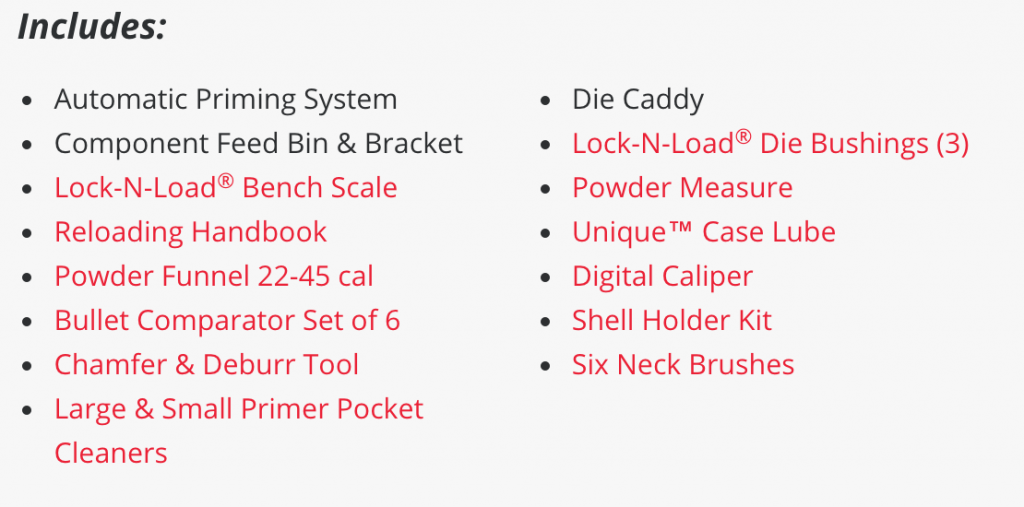
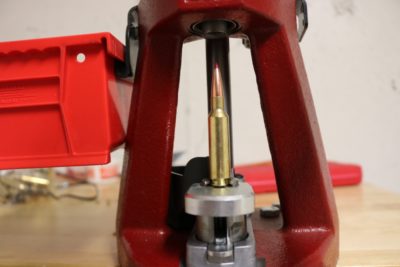
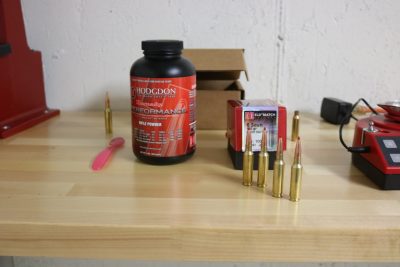
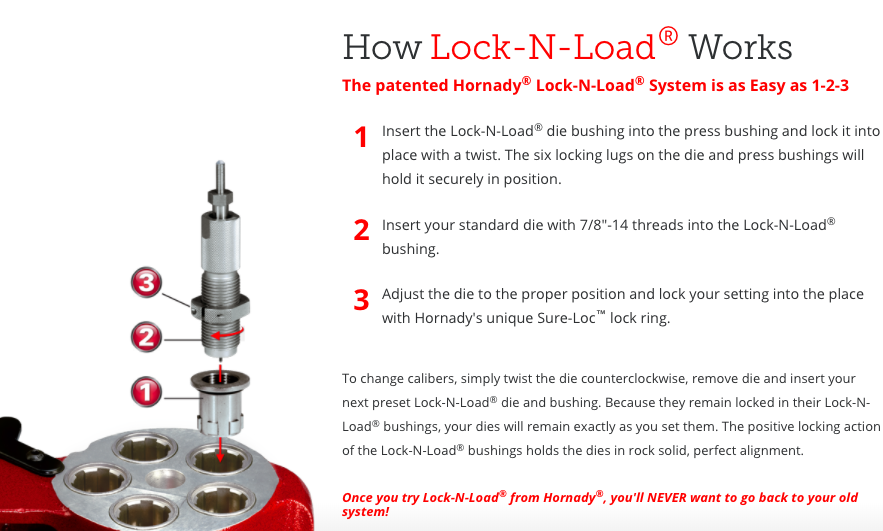
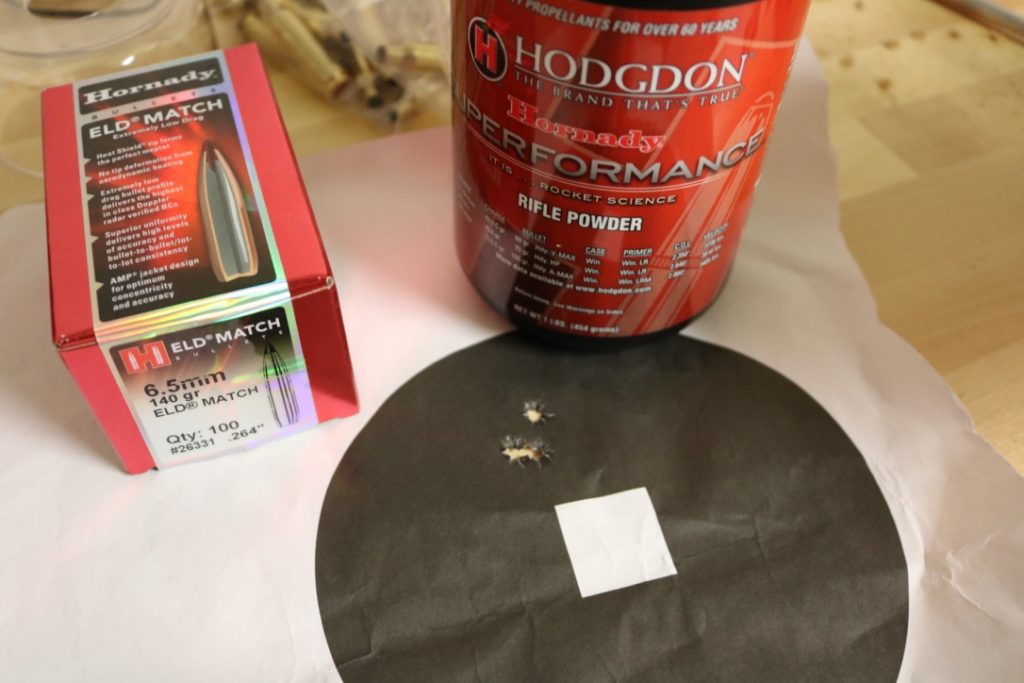
“…I was able to go from unboxing the press to making shootable bullets in about three hours. ”
Oh geeze. Really ? Bullets ?
Well, good job, I guess. I made shootable cartridges for several years before I started making bullets.
After reading all the comments above, ’nuff said.
Just another case of a beginner writing an article being mistaken for an expert writing an article.
One thing that I rarely hear mentioned on any articles about reloading: ZERO YOUR SCALE! I neglected to do this when I first started out. I noticed that some of my .45 ACP loads seemed a little hot. When I got a chrony I found that 230 gr. bullets were going at nearly 1200 fps. Overlooking a simple detail like this could cost someone less lucky than myself an eye or worse.
Clay glad to see you come into our world! Yes my dad taught me how to reload 40 years ago and I have done so on and off since then even using a closet as a reloading room once. I was glad to see you have a new hair cut in the last vid… LOL…. love your stuff and keep them coming… Brad
I think you guys are being a little picky. Heck, I’ve heard people call shotgun shells bullets. Now that’s just wrong. We’ve all heard people refer to a magazine as a clip. When you want some more ammo do you really ask for ammo or cartridges every time or do you say I need some bullets every now and then. I’m sure Clay knows the true definition of a bullet as opposed to a cartridge. Give the guy a break. He does some good and informative videos. I think a lot of you guys that put him down are just jealous that he has a job you would kill for.
man you guys are being a little rough on him!!!!!! Clay while i’ve been reloading for a while I allways find myself reviewing reloading manuals (Lyman, Hornaday and Sierra) and visiting this website: https://www.youtube.com/user/gavintoobe A picture is worth a thousand words my friend.
Unfortunately, like most articles on reloading, this one misses all of the fundamentals … from why shooting enthusiasts should relaod, defining the shooter’s objectives, defining the scope and scale, etc., etc., etc.
Definitely NOT an article that anyone interested in the process should read.
I have been reloading since 1972 and have never needed an press other than a single stage. No one helped or taught me how to reload. Back then there was little literature about the subject beyond reloading manuals. Always start with the book starting load and work your way up. Never substitute cases powder or primers.. Ask any reloader for help, we will be glad to help. Wear safety glasses and don’t reload unless you can devote your full attention to reloading..Never reload while you are tired mentally or physically. Check your cases for defects and above all be safe.You will like some equipment and loath other equipment but develop your own likes and dislikes in equipment. Never assume you know it all YOU NEVER WILL.
As you can tell Clay, the reloading community is very precise in terminology. I have been reloading for 10 years and I learn something new everyday about it. Keep doing what you are doing brother. Better to be judged by 12 then carried by 6
Dittos to what Richard and Rick said .You are loading ammunition or cartridges and not making bullets.Making bullets is usually casting hot lead in a mold to making bullets..Seams like such a simple thing to know the difference. I hear it all the time from people who use firearms….next time some one asks me to pass them some more bullets at the range i will hand them a hand full of Hornaday 165 grain bullets for their firearm and see it that works for them..After all they did request bullets… and not ammo or cartridges…. words mean things. 🙂
That’s why if I rent/borrow a car and they say “Return the tank full of gas” I make sure I drain the tank of every drop of gasoline and give it back with just air in it. Afterall, they did say they wanted a full tank of gas, not gasoline. Gasoline is not stored in the tank is a gaseous form, but air is a gas. Words mean things!
I do my best to use correct terminology with shooting, but do have the occasional slip-up. The best way to turn new shooters away is correct everything they say. Just use the correct terminology yourself and they will catch on.
Living in Kalifornia, with its latest unconstitutional ammo laws, I will begin reloading this year also. I’d rather spend the money on a new guns or optics, but perhaps this will be a better investment in the long term. Clay’s early successful results at the loading bench has raised my hopes as well. Fortunately enough, I have several associates that have been reloading for decades so I should be able to hit the ground running and produce some decent loads myself. Looking forward to seeing more of your reloading results soon sir. – SRG USNV
Reloading certainly can be therapy also it can be dangerous so keeping your head in the game not drinking alcohol while you’re reloading it’s probably a good idea. You could have started with Hornady Lock n Load Progressive press and if you wanted to be careful in the beginning you could have loaded one round at a time. Many many years ago I used to single stage press, but nowadays my wife and I are into action pistol Sports so a single stage would never cut it.
Good luck, have fun, and be careful.
Hmm, ‘primer seated way too deeply’… I’ve been reloading for 25 years… many calibers pistol and rifle. I’ve never heard of a primer being seated too deeply. I don’t think it’s possible if using the correct components. I reload on a pair of Dillon 550B’s. Show us a picture?
I assume he meant a crushed primer, or a deformed one from over pressure during the seating operation.
One reason I prefer hand seating primers (with the Lee system) as opposed to using a press.
Far more ‘feel’ in that system than any press can give.
I personally chuckled at the idea that the Creedmoor is any more or less “forgiving” than other Rifle cartridges, I have found that after 40 years of handloading that they are pretty much all the same in a standard bottle neck type cartridge, with of course some having slight peculiarities, such as bottled necked cartridges like the .357 Sig, or the .400 Cor-Bon, but nothing to concern oneself with.
Good video! Here are a few pointers:You are not making bullets… you are loading ammunition or cartridges. A bullet is the projectile that will be fired from a firearm. Your bullets were made by Hornady. You are assembling cartridges with factory made components. Also, it would have been nice if you had shown the groups fired with the factory ammunition vs. your handloads.If that group was fired with your handloads then you are on track to discover how rewarding handloading can be. One suggestion, get proper ammo boxes for your cartridges and label each box with the caliber, components, charge data, OAL, number of times the case has been loaded and date. Also keep detailed notes on how each load preforms in a particular rifle.Presently, I load 26 different rifle and handgun calibers. I load 30/06 for about 20 different rifles. It would be next to impossible to tailor loads for each individual rifle. In an effort to simplify things I have settled on several loads that perform fantastic in one or two rifles but still give satisfactory results in all the others. Good luck on your new endeavor. I\’ve been handloading for over 45 years… I consider it therapy.
Good video! Here are a few pointers:You are not making bullets… you are loading ammunition or cartridges. A bullet is the projectile that will be fired from a firearm. Your bullets were made by Hornady. You are assembling cartridges with factory made components. Also, it would have been nice if you had shown the groups fired with the factory ammunition vs. your handloads.If that group was fired with your handloads then you are on track to discover how rewarding handloading can be. One suggestion, get proper ammo boxes for your cartridges and label each box with the caliber, components, charge data, OAL, number of times the case has been loaded and date. Also keep detailed notes on how each load preforms in a particular rifle.Presently, I load 26 different rifle and handgun calibers. I load 30/06 for about 20 different rifles. It would be next to impossible to tailor loads for each individual rifle. In an effort to simplify things I have settled on several loads that perform fantastic in one or two rifles but still give satisfactory results in all the others. Good luck on your new endeavor. I’ve been handloading for over 45 years… I consider it therapy.
“Cartridges” not “bullets”, FCS! How can we “gunsplain” to the anti-rights people if we can’t use correct terms ourselves?
All of Clay’s military training seems to have fallen away. Or maybe the “New Army” don’t teach the difference anymore?